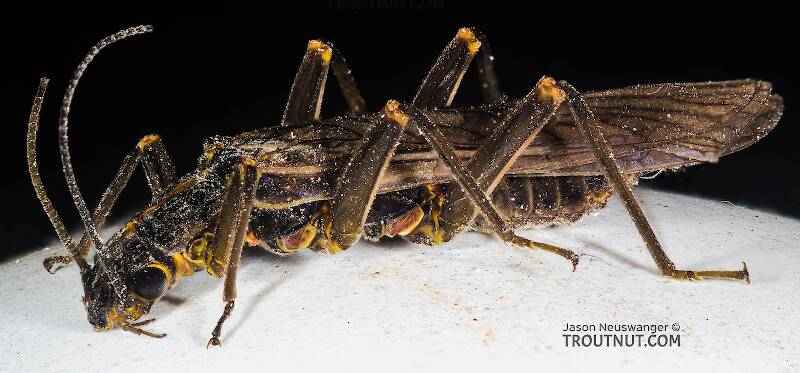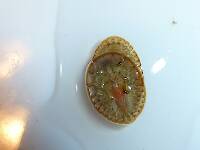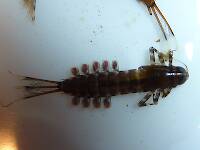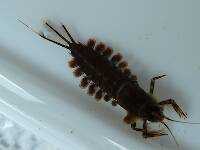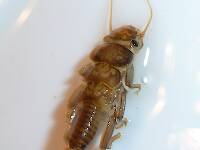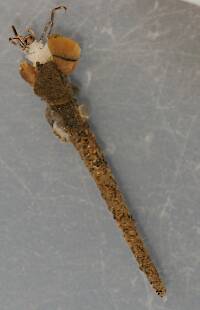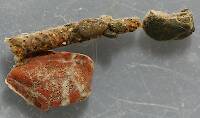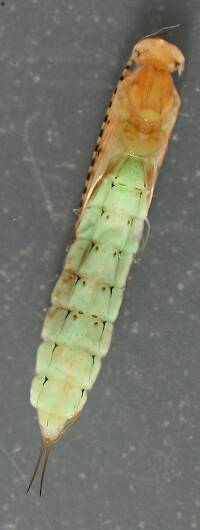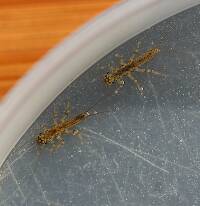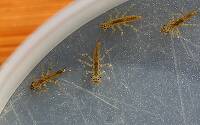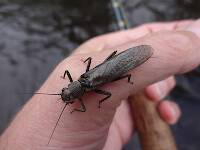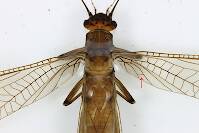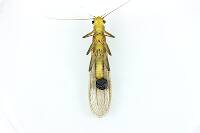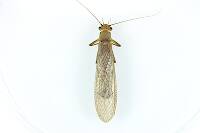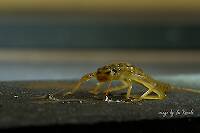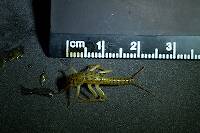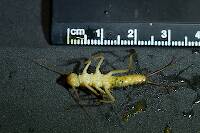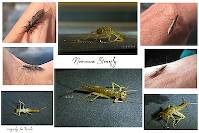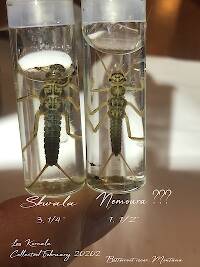
Salmonflies
Pteronarcys californica
The giant Salmonflies of the Western mountains are legendary for their proclivity to elicit consistent dry-fly action and ferocious strikes.
Featured on the forum

Troutnut is a project started in 2003 by salmonid ecologist Jason "Troutnut" Neuswanger to help anglers and
fly tyers unabashedly embrace the entomological side of the sport. Learn more about Troutnut or
support the project for an enhanced experience here.
Entoman on Feb 23, 2012February 23rd, 2012, 7:56 pm EST
Cussfly -
Yes, I noticed the photo artifact too. I think the racing stripe that Paul was referring to is the very wide one that runs dorsally on Peltoperla. That is what I was referring to anyway. Here's a link to a photo that looks like yours. http://www.troutnut.com/specimen/487
I'd be very interested to see photo evidence of the "big three" and your reports on their fishable numbers. One of those clingers in your photos could very well be a quill gordon. The three tailed one most likely isn't a march brown, though. In fact, I don't think it's possible to tell for sure from evidence in the photo if it's even in the same genus. The crawler nymph is probably invaria (prev. rotunda) unless the leg banding is no longer a reliable character. Luke?
Guys, as far as the racing stripe one the roach stonefly, I believe that is just from the flash, because he didn't have that marking in the bowl, just in the pic.
Yes, I noticed the photo artifact too. I think the racing stripe that Paul was referring to is the very wide one that runs dorsally on Peltoperla. That is what I was referring to anyway. Here's a link to a photo that looks like yours. http://www.troutnut.com/specimen/487
As far as the other thing with the Quills, Hendricksons, and March Browns goes, I can assure you they make up a significant enough portion to make some good hatches. Perhaps, the info just has not made it out there yet... But once again, thank you guys for all your help..
I'd be very interested to see photo evidence of the "big three" and your reports on their fishable numbers. One of those clingers in your photos could very well be a quill gordon. The three tailed one most likely isn't a march brown, though. In fact, I don't think it's possible to tell for sure from evidence in the photo if it's even in the same genus. The crawler nymph is probably invaria (prev. rotunda) unless the leg banding is no longer a reliable character. Luke?
"It's not that I find fishing so important, it's just that I find all other endeavors of Man equally unimportant... And not nearly as much fun!" Robert Traver, Anatomy of a Fisherman
PaulRoberts on Feb 24, 2012February 24th, 2012, 7:08 am EST
I see now that the "racing stripe" is from the flash. The Peltoperla I knew from NY were stripe-less too.
Entoman on Feb 24, 2012February 24th, 2012, 9:55 am EST
Paul -
Ah.. The racing stripe I thought you were talking about was the wide pale areas between the wingbuds that connect on the thorax. It could certainly be described that way while holding one in the hand. See this photo of a Peltoperla species http://bugguide.net/node/view/529617.
Sometimes the pale areas aren't that stark, so it is not necessarily a reliable character. Often they are just slightly paler. What is dependable are "...very clear dark pigment spots [on the paler areas] located lateral to [the] ecdysial suture on [the] meso- and metanota" (Stewart and Stark, Nymphs of North American Stonefly Genera, p. 292.). Those spots are a defining characteristic of the genus Peltoperla; they are not found on Tallaperla nymphs.
I think we confused each other over the family name Peltoperlidae vs. the genus name Peltoperla. Your find in NY was most likely Tallaperla maria, being the only species reported from NY (as of 2009) according to B.P. Stark, R.W. Baumann, and R.E. DeWalt. NY also has the species Peltoperla arcuata, but as discussed, it isn't sold brown.
Cussfly - SC has more diversity than NY so there are more species that could fit the characters observable in the photo. I still think it is probably Tallaperla maria, but we'd need to turn it over and get a close up of the gills to know for sure.
Ah.. The racing stripe I thought you were talking about was the wide pale areas between the wingbuds that connect on the thorax. It could certainly be described that way while holding one in the hand. See this photo of a Peltoperla species http://bugguide.net/node/view/529617.
Sometimes the pale areas aren't that stark, so it is not necessarily a reliable character. Often they are just slightly paler. What is dependable are "...very clear dark pigment spots [on the paler areas] located lateral to [the] ecdysial suture on [the] meso- and metanota" (Stewart and Stark, Nymphs of North American Stonefly Genera, p. 292.). Those spots are a defining characteristic of the genus Peltoperla; they are not found on Tallaperla nymphs.
I think we confused each other over the family name Peltoperlidae vs. the genus name Peltoperla. Your find in NY was most likely Tallaperla maria, being the only species reported from NY (as of 2009) according to B.P. Stark, R.W. Baumann, and R.E. DeWalt. NY also has the species Peltoperla arcuata, but as discussed, it isn't sold brown.
Cussfly - SC has more diversity than NY so there are more species that could fit the characters observable in the photo. I still think it is probably Tallaperla maria, but we'd need to turn it over and get a close up of the gills to know for sure.
"It's not that I find fishing so important, it's just that I find all other endeavors of Man equally unimportant... And not nearly as much fun!" Robert Traver, Anatomy of a Fisherman
PaulRoberts on Feb 24, 2012February 24th, 2012, 10:15 am EST
Yes, they were solid rootbeer brown. Tallaperla it is.
Entoman on Apr 1, 2012April 1st, 2012, 10:20 pm EDT
Cussfly -
This specimen of yours is buried pretty far back in the thread.
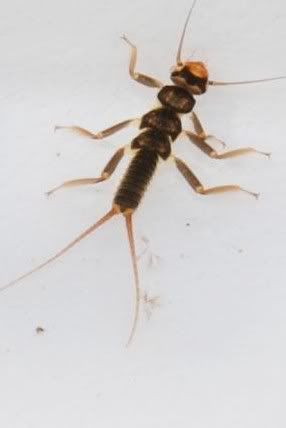
The best I could answer at the time was that it was a perlodid of the Perlodinae or Springfly subfamily. I recognized it, but couldn't remember the name. It's Helopicus subvarians, or Masked Springfly. It is aptly named as the head markings are quite distinctive.
This specimen of yours is buried pretty far back in the thread.
Something different with this stone..?

The best I could answer at the time was that it was a perlodid of the Perlodinae or Springfly subfamily. I recognized it, but couldn't remember the name. It's Helopicus subvarians, or Masked Springfly. It is aptly named as the head markings are quite distinctive.
"It's not that I find fishing so important, it's just that I find all other endeavors of Man equally unimportant... And not nearly as much fun!" Robert Traver, Anatomy of a Fisherman
Quick Reply
Related Discussions
Topic
Replies
Last Reply
9
Jun 19, 2013
by Brookyman
by Brookyman
9
Jun 17, 2015
by Oldredbarn
by Oldredbarn
2
Feb 24, 2020
by Leskorcala
by Leskorcala
8
Jun 12, 2017
by Jmd123
by Jmd123


